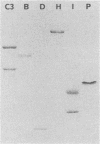Abstract
Encapsulated Cryptococcus neoformans yeast cells are potent activators of the complement system. We examined the interaction of the yeast cells with an alternative complement pathway reconstituted from isolated factor D, factor B, factor H, factor I, C3, and properdin. Incubation of encapsulated cryptococci with the reconstituted pathway led to activation and binding of C3 fragments to the yeast cells that was quantitatively and qualitatively identical to that observed with normal human serum. Incubation with either normal serum or a mixture of isolated proteins led to binding of 4 x 10(7) to 5 x 10(7) C3 molecules to the yeast cells. The kinetics for activation and binding of C3 were identical, with maximum binding observed after a 20-min incubation. Immunoglobulin G was not needed for optimal activation kinetics. C3 fragments eluted from the yeast cells by treatment with hydroxylamine and subsequent analysis by sodium dodecyl sulfate-polyacrylamide gel electrophoresis demonstrated the presence primarily of iC3b on yeast cells incubated with either normal serum or the reconstituted pathway. Ultrastructural examination of the opsonized yeast cells showed that the cryptococcal capsule was the site for binding of C3 activated from normal serum or the reconstituted pathway, with a dense accumulation of C3 at the periphery of the capsule. Thus, incubation of encapsulated cryptococci in the reconstituted pathway led to deposition of opsonic complement fragments at a site that was appropriate for interaction with phagocyte receptors. Cryptococci opsonized with the reconstituted pathway showed a markedly enhanced interaction with cultured human monocytes compared with unopsonized yeast cells, indicating that the alternative pathway alone is opsonic for yeast cells. However, the results indicate that additional serum factors are needed for optimal opsonization of yeast cells because a 35% reduction in the number of cryptococci bound to macrophages was observed with cryptococci opsonized with the reconstituted pathway compared with that observed when yeast cells were opsonized with normal serum.
Full text
PDF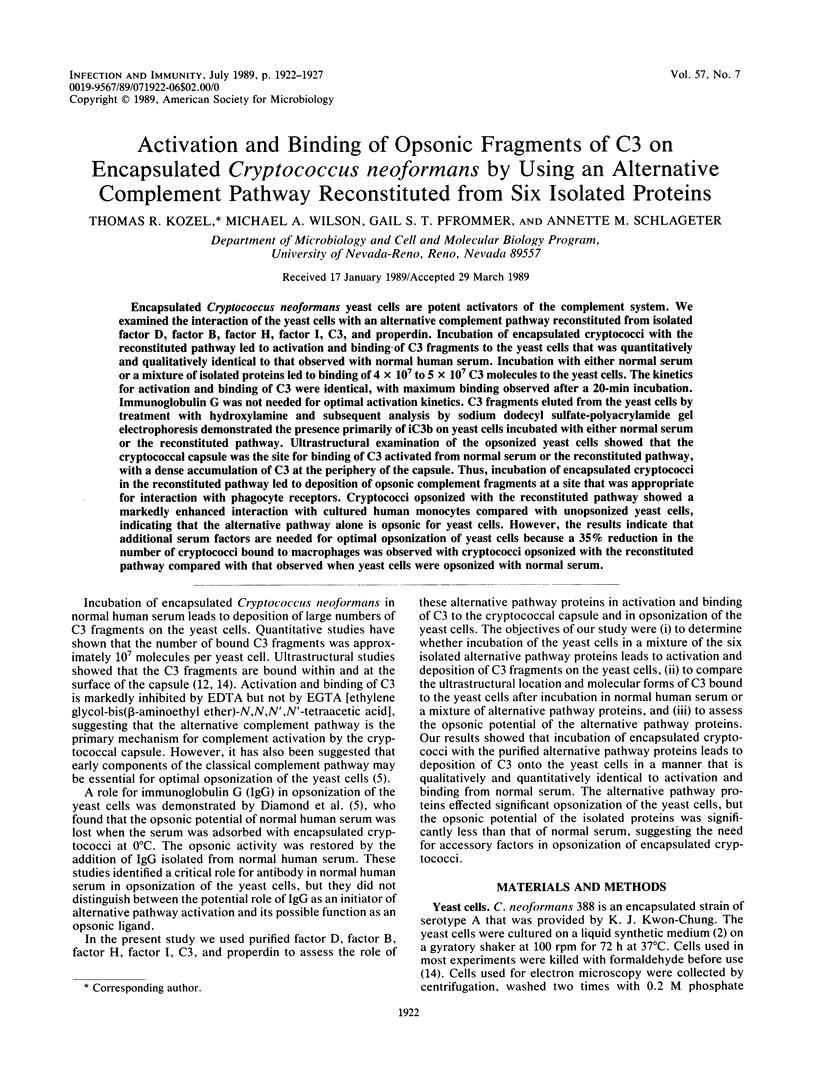
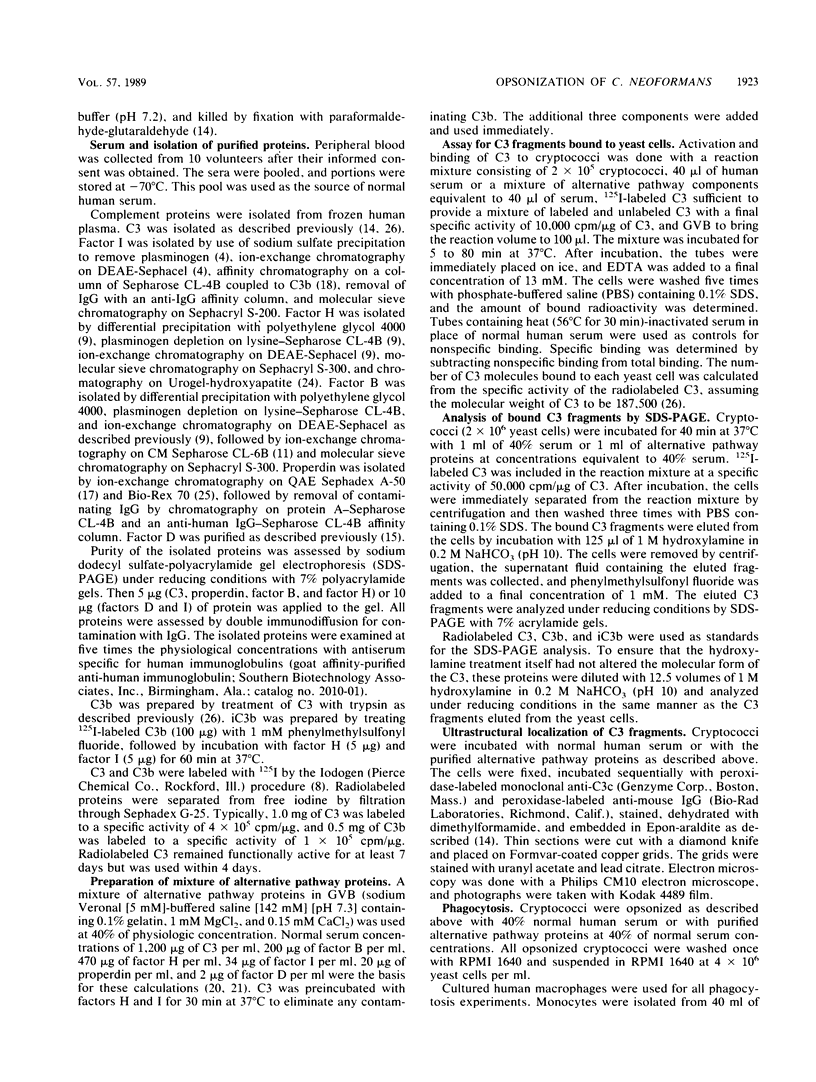
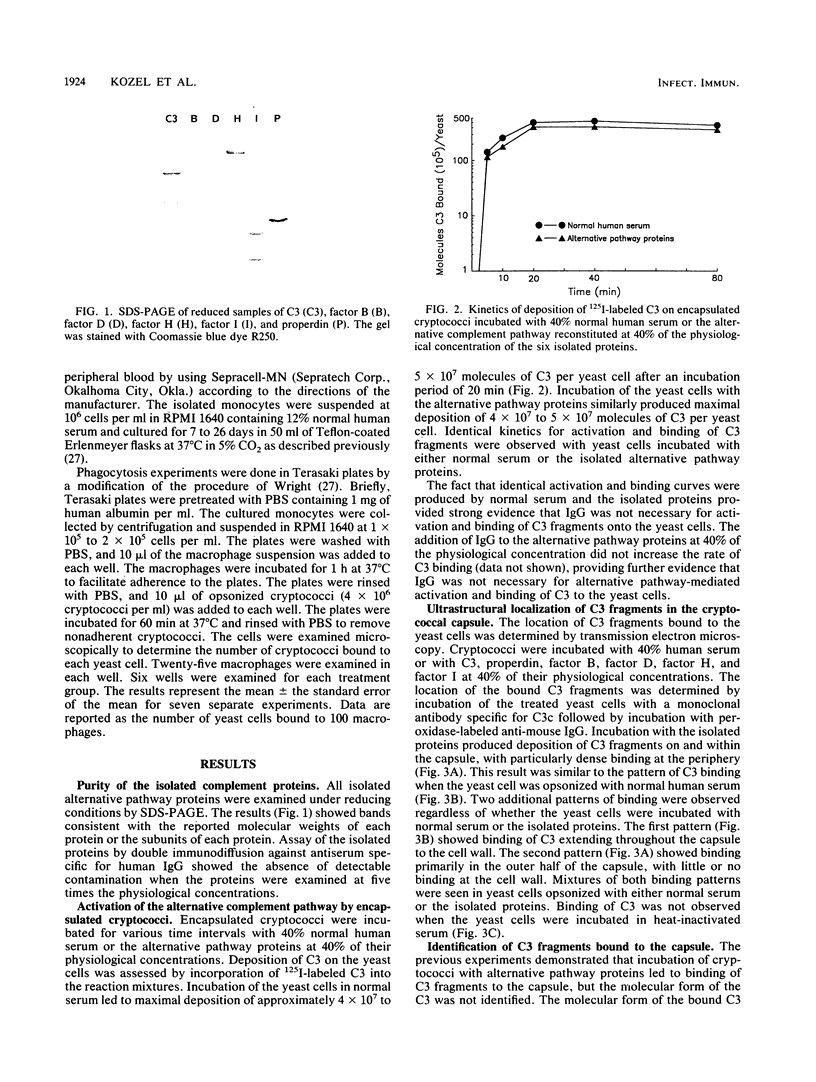

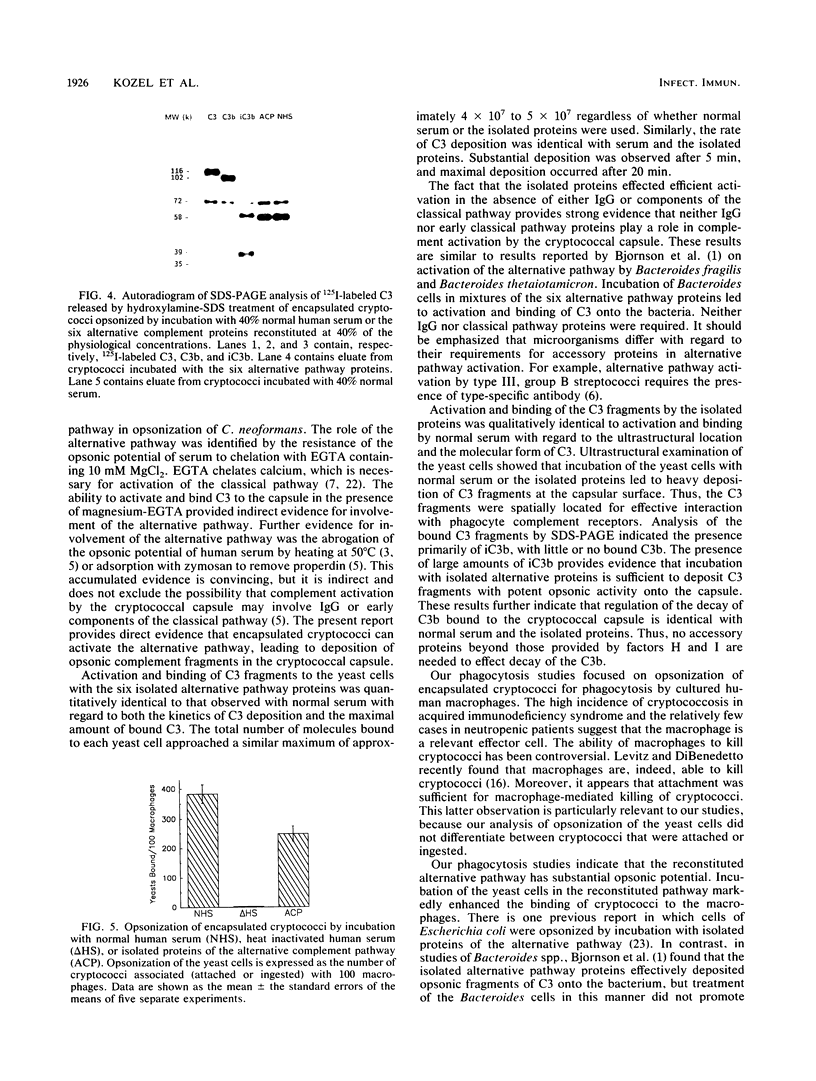

Images in this article
Selected References
These references are in PubMed. This may not be the complete list of references from this article.
- Bjornson A. B., Magnafichi P. I., Schreiber R. D., Bjornson H. S. Opsonization of bacteroides by the alternative complement pathway reconstructed from isolated plasma proteins. J Exp Med. 1987 Mar 1;165(3):777–798. doi: 10.1084/jem.165.3.777. [DOI] [PMC free article] [PubMed] [Google Scholar]
- Davies S. F., Clifford D. P., Hoidal J. R., Repine J. E. Opsonic requirements for the uptake of Cryptococcus neoformans by human polymorphonuclear leukocytes and monocytes. J Infect Dis. 1982 Jun;145(6):870–874. doi: 10.1093/infdis/145.6.870. [DOI] [PubMed] [Google Scholar]
- Davis A. E., 3rd The C3b inactivator of the human complement system: homology with serine proteases. FEBS Lett. 1981 Nov 16;134(2):147–150. doi: 10.1016/0014-5793(81)80588-1. [DOI] [PubMed] [Google Scholar]
- Diamond R. D., May J. E., Kane M. A., Frank M. M., Bennett J. E. The role of the classical and alternate complement pathways in host defenses against Cryptococcus neoformans infection. J Immunol. 1974 Jun;112(6):2260–2270. [PubMed] [Google Scholar]
- Edwards M. S., Nicholson-Weller A., Baker C. J., Kasper D. L. The role of specific antibody in alternative complement pathway-mediated opsonophagocytosis of type III, group B Streptococcus. J Exp Med. 1980 May 1;151(5):1275–1287. doi: 10.1084/jem.151.5.1275. [DOI] [PMC free article] [PubMed] [Google Scholar]
- Fine D. P., Marney S. R., Jr, Colley D. G., Sergent J. S., Des Prez R. M. C3 shunt activation in human serum chelated with EGTA. J Immunol. 1972 Oct;109(4):807–809. [PubMed] [Google Scholar]
- Fraker P. J., Speck J. C., Jr Protein and cell membrane iodinations with a sparingly soluble chloroamide, 1,3,4,6-tetrachloro-3a,6a-diphrenylglycoluril. Biochem Biophys Res Commun. 1978 Feb 28;80(4):849–857. doi: 10.1016/0006-291x(78)91322-0. [DOI] [PubMed] [Google Scholar]
- Hammer C. H., Wirtz G. H., Renfer L., Gresham H. D., Tack B. F. Large scale isolation of functionally active components of the human complement system. J Biol Chem. 1981 Apr 25;256(8):3995–4006. [PubMed] [Google Scholar]
- Harrison R. A., Lachmann P. J. The physiological breakdown of the third component of human complement. Mol Immunol. 1980 Jan;17(1):9–20. doi: 10.1016/0161-5890(80)90119-4. [DOI] [PubMed] [Google Scholar]
- Kerr M. A. Human factor B. Methods Enzymol. 1981;80(Pt 100):102–112. doi: 10.1016/s0076-6879(81)80010-9. [DOI] [PubMed] [Google Scholar]
- Kozel T. R., Highison B., Stratton C. J. Localization on encapsulated Cryptococcus neoformans of serum components opsonic for phagocytosis by macrophages and neutrophils. Infect Immun. 1984 Feb;43(2):574–579. doi: 10.1128/iai.43.2.574-579.1984. [DOI] [PMC free article] [PubMed] [Google Scholar]
- Kozel T. R., Pfrommer G. S. Activation of the complement system by Cryptococcus neoformans leads to binding of iC3b to the yeast. Infect Immun. 1986 Apr;52(1):1–5. doi: 10.1128/iai.52.1.1-5.1986. [DOI] [PMC free article] [PubMed] [Google Scholar]
- Kozel T. R., Pfrommer G. S., Guerlain A. S., Highison B. A., Highison G. J. Strain variation in phagocytosis of Cryptococcus neoformans: dissociation of susceptibility to phagocytosis from activation and binding of opsonic fragments of C3. Infect Immun. 1988 Nov;56(11):2794–2800. doi: 10.1128/iai.56.11.2794-2800.1988. [DOI] [PMC free article] [PubMed] [Google Scholar]
- Lesavre P. H., Hugli T. E., Esser A. F., Müller-Eberhard H. J. The alternative pathway C3/C5 convertase: chemical basis of factor B activation. J Immunol. 1979 Aug;123(2):529–534. [PubMed] [Google Scholar]
- Levitz S. M., DiBenedetto D. J. Differential stimulation of murine resident peritoneal cells by selectively opsonized encapsulated and acapsular Cryptococcus neoformans. Infect Immun. 1988 Oct;56(10):2544–2551. doi: 10.1128/iai.56.10.2544-2551.1988. [DOI] [PMC free article] [PubMed] [Google Scholar]
- Medicus R. G., Esser A. F., Fernandez H. N., Müller-Eberhard H. J. Native and activated properdin: interconvertibility and identity of amino- and carboxy-terminal sequences. J Immunol. 1980 Feb;124(2):602–606. [PubMed] [Google Scholar]
- Nagasawa S., Ichihara C., Stroud R. M. Cleavage of C4b by C3b inactivator: production of a nicked form of C4b, C4b', as an intermediate cleavage product of C4b by C3b inactivator. J Immunol. 1980 Aug;125(2):578–582. [PubMed] [Google Scholar]
- Newman S. L., Mikus L. K. Deposition of C3b and iC3b onto particulate activators of the human complement system. Quantitation with monoclonal antibodies to human C3. J Exp Med. 1985 Jun 1;161(6):1414–1431. doi: 10.1084/jem.161.6.1414. [DOI] [PMC free article] [PubMed] [Google Scholar]
- Pangburn M. K., Morrison D. C., Schreiber R. D., Müller-Eberhard H. J. Activation of the alternative complement pathway: recognition of surface structures on activators by bound C3b. J Immunol. 1980 Feb;124(2):977–982. [PubMed] [Google Scholar]
- Platts-Mills T. A., Ishizaka K. Activation of the alternate pathway of human complements by rabbit cells. J Immunol. 1974 Jul;113(1):348–358. [PubMed] [Google Scholar]
- Schreiber R. D., Pangburn M. K., Bjornson A. B., Brothers M. A., Müller-Eberhard H. J. The role of C3 fragments in endocytosis and extracellular cytotoxic reactions by polymorphonuclear leukocytes. Clin Immunol Immunopathol. 1982 May;23(2):335–357. doi: 10.1016/0090-1229(82)90119-2. [DOI] [PubMed] [Google Scholar]
- Sim R. B., DiScipio R. G. Purification and structural studies on the complement-system control protein beta 1H (Factor H). Biochem J. 1982 Aug 1;205(2):285–293. doi: 10.1042/bj2050285. [DOI] [PMC free article] [PubMed] [Google Scholar]
- Smith C. A., Pangburn M. K., Vogel C. W., Müller-Eberhard H. J. Molecular architecture of human properdin, a positive regulator of the alternative pathway of complement. J Biol Chem. 1984 Apr 10;259(7):4582–4588. [PubMed] [Google Scholar]
- Wright S. D. Methods for the study of receptor-mediated phagocytosis. Methods Enzymol. 1986;132:204–221. doi: 10.1016/s0076-6879(86)32009-3. [DOI] [PubMed] [Google Scholar]



